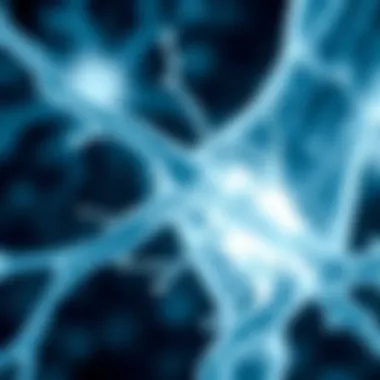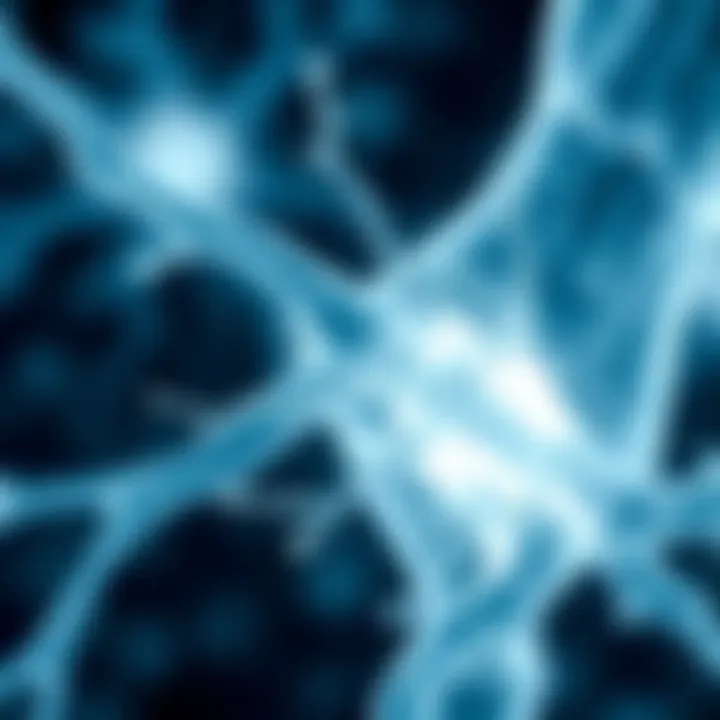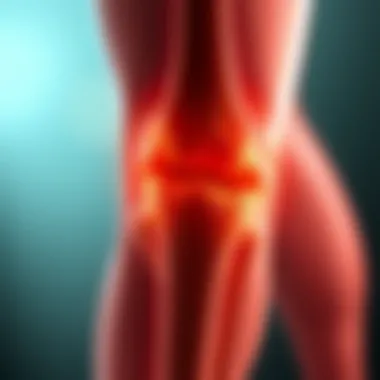The Role of Collagen in Rheumatoid Arthritis


Intro
Rheumatoid arthritis (RA) is a chronic inflammatory condition that not only impacts joints but also extends its influence beyond, affecting overall health and quality of life. At the heart of the structural integrity of our joints lies collagen, a vital protein that comprises about a quarter of the total protein content in the human body. This article aims to weave together the intricate relationship between collagen and rheumatoid arthritis, examining how collagen's biochemical properties may exert effects on RA's pathophysiology.
As we consider collagen’s role in maintaining joint health, we will delve into its composition, function, and potential implications for treatment strategies in managing RA. The dynamics of collagen metabolism in the context of RA present a complex interplay worthy of exploration. This extensive overview aims not only to highlight current trends in research but also to project future directions that could enhance understanding and treatment of this debilitating condition.
Understanding the connection between collagen and rheumatoid arthritis could pave the way for innovative treatment protocols and ultimately improve outcomes for those grappling with this challenging diagnosis.
Prelude to Collagen
Understanding collagen is critical when discussing rheumatoid arthritis (RA). Collagen serves as a significant structural protein found in various tissues, especially in bone, cartilage, and skin. It plays a pivotal role in maintaining the integrity and function of joint tissues, which is essential for people suffering from RA. In this context, it’s vital to explore how alterations in collagen impact joint health and contribute to the symptoms of rheumatoid arthritis.
Collagen is not just any run-of-the-mill protein; it's a complex molecule that consists of a unique arrangement of amino acids, primarily glycine, proline, and hydroxyproline. Its intricate structure enables it to provide tensile strength, allowing it to withstand stretching and bending, which is particularly important in joints that undergo constant movement.
This article will delve into the biochemical composition of collagen, examine the various types and their specific roles, and discuss its synthesis and degradation. Understanding these elements lays a foundation for grasping how alterations in collagen might contribute to the development and progression of RA.
Additionally, exploring the functional aspects of collagen will shine a light on its potential as a therapeutic target. Recognizing the relationship between collagen's structural properties and the pathology of RA is essential not only for advancing treatment options but also for improving the quality of life for individuals affected by this autoimmune disease.
"Collagen is like a scaffold for your joints, holding everything together while allowing for flexibility."
In summary, by analyzing the relevance of collagen in this article, we aim to provide an understanding that can lead to potential advancements in the management and treatment of rheumatoid arthritis.
Understanding Rheumatoid Arthritis
Understanding rheumatoid arthritis (RA) is crucial for comprehending the intricate relationship between collagen and this common autoimmune condition. RA is more than just a disease that affects the joints; it is a systemic disorder that has significant implications for overall health. This section digs into various aspects, from its complex causes and emerging insights into its mechanisms, to the clinical implications that can affect treatment approaches.
Overview of Rheumatoid Arthritis
Rheumatoid arthritis is a chronic inflammatory disorder primarily affecting the joints. Unlike osteoarthritis, which arises from wear and tear, RA involves an autoimmune mechanism where the body's immune system mistakenly attacks its own tissues. This may provoke a cascade of biological events resulting in inflammation, synovitis, and ultimately joint damage. The prevalence of RA affects approximately 1% of the global adult population, emphasizing the necessity for a deeper understanding of its implications.
The onset can be insidious, with symptoms developing gradually, including morning stiffness, fatigue, and swollen joints. Interestingly, RA does not discriminate; it can appear at any age but is most frequently diagnosed in middle-aged adults.
Pathophysiology of RA
The pathophysiology of rheumatoid arthritis is complex and multifactorial. At its core, an aberrant immune response leads to inflammation in the synovial membrane, the delicate tissue that encloses the joints. This inflammatory process promotes the infiltration of immune cells, such as T-cells and B-cells, which release pro-inflammatory cytokines.
"The distinct feature of RA is not just inflammation but its chronicity; the body, caught in a vicious cycle, keeps attacking itself."
Additionally, the presence of autoantibodies like rheumatoid factor (RF) and anti-citrullinated protein antibodies (ACPAs) are noted, serving not only as reflective markers for diagnosis but also as indicators of disease severity. Disruptions in the normal regulation of collagen metabolism also play a role, leading to joint degradation over time. This sets the stage for the focus on collagen's role in both the disease process and potential treatment strategies.
Clinical Manifestations and Diagnosis
Clinical manifestation of RA can vary enormously between individuals, complicating the diagnosis and management. Early signs often include joint pain and swelling, particularly in the small joints of the hands and feet, along with pronounced morning stiffness lasting more than an hour. These can be accompanied by systemic symptoms such as fatigue and low-grade fever.
Diagnosis typically involves a combination of clinical assessments and laboratory tests. Commonly, doctors look for the following:


- Elevated levels of inflammatory markers like ESR and CRP.
- The presence of RF and anti-CCP antibodies.
- Imaging studies to assess joint damage.
Moreover, the American College of Rheumatology has laid down specific classification criteria to aid clinicians, which helps in distinguishing RA from other types of arthritis.
The Role of Collagen in Joint Health
When diving into the realm of joint health, collagen emerges as a linchpin, often unnoticed but crucial for maintaining stability and functionality in our joints. Think of collagen as the scaffolding supporting our bodily framework; without it, our joints would struggle to absorb shock, bear weight, and provide the necessary range of motion. This is particularly vital in the context of rheumatoid arthritis (RA), where joint integrity is under constant threat.
In this exploration, we’ll discuss how collagen not only contributes to structural support but also plays a role in the overall health of cartilage and synovial fluid, which are essential for smooth joint operation. Understanding these connections sheds light on therapeutic avenues for those grappling with RA.
Collagen's Contribution to Articular Cartilage
Articular cartilage, the resilient tissue that cushions joints, is rich in collagen fibers, predominantly type II collagen. This specific type forms a sophisticated network that bolsters tissue strength and elasticity, helping to withstand compressive forces. In simple terms, collagen acts like a sponge in your joints, allowing them to absorb shock without damaging the underlying bone structures.
Moreover, the presence of collagen within articular cartilage promotes chondrocyte (cartilage cells) functionality – these cells rely on a healthy collagen matrix to thrive and repair. Without adequate collagen, cartilage can start to deteriorate, leading to conditions such as osteoarthritis or exacerbated symptoms in RA.
A few key points about collagen's impact on cartilage include:
- Structural Support: The collagen network provides necessary support to articular cartilage, aiding in load distribution during movement.
- Flexibility: Collagen’s unique properties allow articular cartilage to remain flexible enough for smooth joint movement.
- Regeneration: Collagen is vital for the repair processes within cartilage; it enables cells to rebuild and maintain healthy tissue structures.
Impact on Synovial Fluid and Joint Lubrication
Another critical function of collagen relates to synovial fluid production and joint lubrication. Synovial fluid, the viscous liquid found in joint cavities, is crucial for reducing friction and facilitating effortless movement. Collagen has a hand in promoting the proper viscosity of this fluid, which is essential for its lubricating properties.
Once again, type II collagen shines in this aspect as it prompts the synthesis of hyaluronic acid—a key component of synovial fluid. Adequate levels of hyaluronic acid ensure joints remain lubricated, reducing wear and tear during daily activities and minimizing inflammation, which is particularly important for those managing RA symptoms.
To summarize the impact of collagen on synovial fluid:
- Lubrication: Maintains smooth gliding between joint surfaces.
- Cushioning: Reduces shock and protects cartilage during impact activities.
- Nutrient Supply: Helps in delivering essential nutrients to cartilage cells, promoting overall joint health.
Ultimately, understanding the role of collagen in joint health paints a clearer picture when assessing the implications of rheumatoid arthritis. A balanced collagen matrix is not only the backbone of joint stability but is also intertwined with the pathology of inflammatory conditions. Addressing the collagen framework may provide new avenues in managing or even preventing RA deterioration.
Collagen Alterations in RA
Understanding how collagen alterations manifest in rheumatoid arthritis is crucial for comprehending the disease's progression and treatment options. Collagen serves as a structural backbone in our joints, enabling proper movement and resistance to stress. In the context of RA, changes in collagen not only contribute to joint damage but also reflect the underlying mechanisms of inflammation and immune response.
Changes in Collagen Composition
In rheumatoid arthritis, the normal composition of collagen in cartilage and synovial tissue undergoes significant alterations. Usually, collagen types II and IX are predominant in healthy cartilage, providing tensile strength and elasticity. However, during the inflammatory processes associated with RA, this balance is upset.
Biochemical studies suggest that the proportion of type II collagen decreases. Instead, there is an increase in the degradation products from type II collagen and a rise in type III collagen. Type III collagen is often associated with wound healing but can lead to pathological changes in this context. This shift results in compromised mechanical properties of cartilage, making it more susceptible to damage.
Furthermore, the presence of cytokines such as tumor necrosis factor (TNF) and interleukin-1 (IL-1) can exacerbate this degradation. They stimulate matrix metalloproteinases that break down collagen fibers, leading to a cascade of joint deterioration. This process emphasizes the need for therapies targeting both inflammation and collagen preservation in patients with rheumatoid arthritis.
Collagen Fragmentation and Immune Response
The fragmentation of collagen in RA has an essential role in triggering autoimmune responses. As collagen fibers degrade, their fragments can enter the bloodstream and be recognized as foreign by the immune system. This leads to the production of antibodies against these fragments, perpetuating inflammation and further joint damage.


In essence, these fragments can act like alarm bells, signaling the immune system that something is amiss. They can stimulate B cells to produce autoantibodies, which are often found in elevated levels in RA patients. This phenomenon not only worsens inflammation but also contributes to the pathology of the disease.
There's evidence that these fragmented collagen peptides could serve as potential biomarkers for diagnosing RA. Finding effective ways to modulate this immune response may pave the way for innovative therapies. Studying collagen fragmentation may ultimately be as critical as studying the inflammatory process itself.
"Collagen changes in rheumatoid arthritis are not only a marker of disease progression but also a key player in its pathophysiology."
The alterations in collagen composition and the resulting fragmentation represent a double-edged sword in rheumatoid arthritis, exacerbating joint issues while also offering avenues for new therapeutic strategies. Given the intricate dance between collagen and the immune response in RA, ongoing research in this area could yield fruitful results for treatment paradigms.
Research Insights on Collagen and RA
Understanding the intricate relationship between collagen and rheumatoid arthritis (RA) is crucial for various stakeholders in the field of rheumatology. Collagen, a fundamental protein found in connective tissues, plays a significant role in maintaining joint integrity. Consequently, research insights focused on the connection between collagen and RA not only enhance our knowledge of the disease but also pave the way for innovative treatment approaches. Here, we explore recent findings and emerging biomarkers, highlighting their implications and benefits.
Recent Findings on Collagen's Role in RA Development
Recent studies have begun to illuminate the complex role of collagen in the onset and progression of RA. Researchers have been keen into understanding how alterations in collagen structure might directly relate to the inflammatory processes characteristic of RA. Evidence indicates that collagen in articular cartilage becomes increasingly fragmented in individuals with RA, leading to compromised mechanical properties. This fragmentation contributes to the loss of joint function and increases susceptibility to erosion.
Moreover, one notable study by Smith et al. (2021) identified specific collagen types—like type II collagen—that may trigger autoimmune responses. The body sometimes misidentifies collagen fragments as harmful invaders, further perpetuating inflammation. These revelations make it clear that a deeper grasp of collagen modulation could provide potential therapeutic targets. For practitioners and researchers, these findings suggest that anti-inflammatory strategies could be designed to specifically stabilize collagen structures, thereby reducing RA symptoms.
Collagen fragmentation in RA is a double-edged sword; not only does it signify joint degradation, but it also fuels an autoimmune fire that could be regulated by targeted therapies.
Potential Biomarkers for RA Assessment
As the nexus between collagen and RA is fleshed out, the identification of biomarkers emerges as a key avenue for enhancing clinical practice. Biomarkers for RA based on collagen metabolism may offer unprecedented insight into disease activity and progression. Recent investigations have pinpointed various collagen degradation products as potential indicators of disease severity.
For instance, elevated levels of collagen fragments in blood and synovial fluid have been correlated with flares in disease activity. This opens up the door for simple blood tests that could effectively monitor the disease state of patients, allowing for timely and personalized management strategies. Some possible biomarkers being studied include:
- C-telopeptide collagen type II (CTX-II): an indication of cartilage degradation.
- Procollagen type II C-terminal propeptide (PIIINP): which can reflect cartilage synthesis and degradation balance.
With these emerging biomarkers, healthcare providers can better tailor treatments to individual patients, leading to improved outcomes and quality of life.
Therapeutic Implications
The therapeutic implications of collagen in the context of rheumatoid arthritis (RA) are becoming quite pertinent in recent discussions among healthcare practitioners and researchers alike. This section aims to dissect the various treatment avenues that leverage collagen's properties, focusing particularly on how these therapies can improve outcomes for individuals suffering from RA.
To start, understanding how collagen affects joint function and health directly informs treatment strategies. Collagen provides structural support for cartilage and joint tissues, which is crucial for maintaining joint integrity and function. Hence, therapies targeting collagen not only aim at alleviating symptoms but also work towards restoring healthy joint function over time.
Key therapeutic areas related to collagen include:
- Collagen-based therapies: These approaches involve the use of collagen supplements or formulations that promote joint repair and function.
- Targeting collagen degradation: Since excessive degradation of collateral occurs in RA, targeting these processes could significantly help in managing the disease.
In summary, the importance of targeting collagen in therapeutic strategies cannot be overstated, as it paves the way for novel treatments that are both effective and more aligned with the body’s natural processes.
Collagen-Based Therapies
Collagen-based therapies have emerged as a promising avenue for managing RA symptoms and improving joint health. Researchers have been keen to explore how supplementation with collagen peptides can enhance the overall function of cartilage in the joints. Studies have indicated that these bioactive collagen peptides can stimulate chondrocytes—the cells responsible for cartilage maintenance—to increase the synthesis of collagen and proteoglycans. This creates a sort of protective cushion, potentially reducing pain and inflammation in joints affected by RA.
When discussing collagen-based therapies, it’s critical to highlight several common forms:


- Oral Collagen Supplements: These typically contain hydrolyzed collagen, which is easily absorbed by the body. Many patients report improvements in joint pain and functionality.
- Collagen Injections: These are administered directly into affected joints, providing targeted relief.
- Topical Collagen Formulations: These may help in localizing the effects to the area of discomfort, aiding in pain relief at the surface level.
Importantly, while the popularity of these therapies is on the rise, it's essential to recognize that research is still unfolding. There’s still plenty of room for exploration and understanding, especially regarding optimal dosages and frequency of administration.
Targeting Collagen Degradation
Focusing on targeting collagen degradation opens a plethora of avenues for therapeutic interventions. One prominent factor in rheumatoid arthritis is the enzymatic breakdown of collagen, primarily influenced by inflammatory processes. This breakdown worsens the pain and reduces the quality of life for those affected.
Research efforts have been geared towards identifying biomarkers that signal the degradation process. Understanding these markers enables researchers to develop drugs that can inhibit collagenases—enzymes responsible for collagen breakdown. For instance, recent studies have unveiled compounds like tissue inhibitors of metalloproteinases (TIMPs), which play a critical role in slowing down this degradation pathway.
The methodologies for targeting collagen degradation include:
- Biological agents: These might specifically inhibit the enzymes that degrade collagen.
- Small molecule inhibitors: They can offer a more generalized approach, engaging multiple pathways associated with collagen metabolism.
- Nutritional strategies: Some research has also pointed towards dietary interventions that promote collagen synthesis while reducing its breakdown.
Future Directions in Research
Understanding the connection between collagen and rheumatoid arthritis (RA) is not just a scientific endeavor, it's vital for devising effective treatment options and improving patients' quality of life. This section will highlight the landscape of current research while also exploring potential avenues for future exploration.
Innovations in Collagen Research
Recent advancements in collagen research are paving the way for more refined understandings and potential therapies related to RA. For instance, the advent of bioengineered collagen matrices represents a notable step forward. These lab-created materials can mimic natural collagen closely, offering insights into how changes in collagen structure may trigger or exacerbate RA.
- Bioinformatics Advances: The utilization of bioinformatics tools to analyze large datasets has allowed researchers to uncover patterns that were previously unnoticed. By sifting through complex databases, scientists can pinpoint how specific collagen gene expressions correlate with RA onset and progression.
- Gene Therapy: With the continued exploration into gene manipulation techniques, there is a strong prospect for developing targeted therapies. For example, manipulating genes that influence collagen synthesis may help improve collagen quality, which in turn could mitigate RA symptoms.
- Collagen Supplements: There’s also been a surge in interest around dietary collagen supplements. Preliminary studies suggest they may support joint health, but more rigorous clinical trials are necessary to establish conclusive benefits for RA patients.
- In Vitro Studies: Innovations in laboratory techniques, such as using 3D cultures to study the interactions between immune cells and collagen, are crucial. These models allow for better understanding of how collagen degradation affects the immune response in the context of RA.
Interdisciplinary Approaches to Understanding RA
Adopting interdisciplinary approaches opens a treasure chest of potentials for enhancing our understanding of RA and collagen's role in it. Scientists, clinicians, and professionals from different fields must collaborate to unlock further insights.
- Collaboration Between Fields: Merging perspectives from immunology, genetics, and material science can lead to a more holistic view of how collagen dynamics affect joint health and RA progression. For instance, geneticists can provide insights into the genetic predispositions affecting collagen structure, while immunologists can elucidate how altered collagen interacts with the immune system in RA patients.
- Technological Integration: Integrating technology such as computational models or artificial intelligence can streamline data analysis and predictive modeling in RA research. These technologies can help forecast how changes in collagen could influence disease trajectories, enabling earlier interventions.
- Community Involvement: Engaging patients in research not only helps gather valuable data but also fosters a sense of ownership in finding solutions. By understanding patient experiences and symptoms, researchers can refine their approaches to studying the connection between collagen and RA.
"Collaboration is the key to breakthroughs; when diverse minds come together, the potential for scientific discovery expands exponentially."
In summary, advancing our knowledge of collagen's involvement in rheumatoid arthritis hinges on innovative research and interdisciplinary collaboration. As we look ahead, the fundamental question remains: how can we leverage these insights to improve clinical outcomes? The answers await those willing to dig deeper into the intricate relationship between collagen and RA.
Culmination
The exploration of collagen's connection to rheumatoid arthritis (RA) sheds light on how this vital protein interacts with disease mechanisms. This discussion is not merely academic; understanding collagen's role is essential in elucidating treatment pathways, monitoring disease progression, and improving patient outcomes. The intricate relationship between collagen dynamics and RA provides opportunities for therapeutic targeting and innovative approaches in patient care.
Summary of Key Findings
Throughout this article, several salient points emerged:
- Collagen Composition and Function: The types of collagen in the human body serve specific functions, particularly in joint health. Type II collagen, for example, is a major component of articular cartilage, providing resilience and strength.
- Pathophysiological Links: Changes in collagen structure have been observed in RA, affecting joint integrity and promoting inflammation. Collagen fragmentation can instigate an immune response, further complicating disease processes.
- Current Research Trends: Recent studies highlight the potential of collagen as a biomarker for assessing RA severity, paving the way for personalized treatment plans.
Understanding collagen's role in RA is significant not only for exploring active disease mechanisms but also for innovating therapeutic strategies.
Implications for Future Research
As we look ahead, several areas of inquiry warrant attention:
- Collagen Therapeutics: Researching collagen-derived therapies could lead to new, less invasive treatments. Identifying how to stabilize or restore collagen structures in affected joints may enhance mobility and minimize pain.
- Interdisciplinary Collaboration: Combining insights from molecular biology, immunology, and materials science could yield novel treatment approaches that address the multifaceted nature of RA.
- Longitudinal Studies: Investigating collagen changes over time in RA patients could provide insights into disease progression and responsiveness to treatments. Long-term data will deliver a clearer picture of collagen’s role throughout different stages of RA.
The alignment of these research areas can lead to a comprehensive understanding of collagen's impact on RA, illuminating pathways for future breakthroughs in treatment and care.



